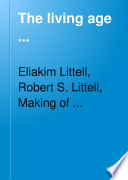 | 1897 - 918 pages
...lines on the side towards the blue, all the three lines being separated by intervals relatively dark. The riddle of the nebulae was solved. The answer,...read: Not an aggregation of stars, but a luminous gas. Stars after the order of our own sun, and of the brighter stars, would give a different spectrum; the... | |
 | 1900 - 600 pages
...lines on the side toward the blue, all the three lines being separated by intervals relatively dark. The riddle of the nebulae was solved. The answer,...read: Not an aggregation of stars, but a luminous gas. Stars after the order of our own sun, and of the brighter stars, would give a different spectrum; the... | |
 | 1902 - 584 pages
...towards the blue, all three lines being separated by intervals relatively dark. The riddle of the nebulas was solved. The answer, which had come to us in the...Not an aggregation of stars, but a luminous gas." With this advance a new era of progress began. The power of the spectroscope to distinguish between... | |
 | George Iles - 1900 - 486 pages
...nebula in Draco, by Ur. (now Sir) William Htiggins. This is what he saw : The riddle of the nebulie was solved. The answer, which had come to us in the light itself, read, Not an aggregation of stars, PLATK XVIII. THE NKHULA IN ORION. From the drawing by Professor GP Bond, 1859-^3. Pi ••* Xi.< 1... | |
 | 1902 - 230 pages
...William Huggins. This is what he saw: "The riddle of the nebulae was solved. The answer, which kad come to us in the light itself, read, Not an aggregation of stars, but a luminous gas. Stars after the order of our own sun, and of the brighter stars, would give a different spectrum, the... | |
 | Smithsonian Institution. Board of Regents - 1903 - 902 pages
...separated by intervals relatively' dark. The riddle of the nebulœ was solved. The answer, which hacl come to us in the light itself, read: Not an aggregation of stars, but a luminous gas." With this advance a new era of progress began. The power of the spectroscope to distinguish between... | |
 | Astronomical Society of the Pacific - 1904 - 356 pages
...towards the blue, all the three lines being separated by intervals relatively dark. He proclaimed : — " The riddle of the nebulae was solved. The answer which...read: Not an aggregation of stars, but a luminous gas. Stars after the order of our Sun, and of the brighter stars, would give a different spectrum ; the... | |
 | William Marshall Watts - 1904 - 414 pages
...on the side towards the blue, all the three lines being sepa rated by intervals relatively dark. " The riddle of the nebulae was solved. The answer,...: Not an aggregation of stars, but a luminous gas. Stars after the order of our own sun, and of the brighter stars, would give a different spectrum ;... | |
 | George Ellery Hale - 1908 - 482 pages
...bright lines on the side toward the blue, all three lines being separated by intervals relatively dark. The riddle of the nebulae was solved. The answer,...read: Not an aggregation of stars, but a luminous gas. With this advance a new era of progress began. The power of the spectroscope to distinguish between... | |
 | 1909 - 510 pages
...but in methods of research. — or on the spectra of comets, or of the iixed stars, or of nebulae, or of temporary stars, or of motion in the line of...of stars, but a luminous gas." The all prevailing hydrogen was there, and, as future researches have shown, its sympathetic companion helium. In 1882... | |
| |